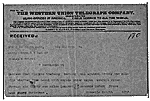Today in History: December 17
First Flight
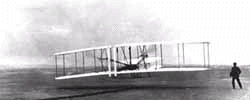
First Flight, December 17, 1903
John T. Daniels, photographer.
Prints and Photographs Division
American Treasures of the Library of Congress
On the morning of December 17, 1903, Wilbur and Orville Wright took turns piloting and monitoring their flying machine in Kill Devil Hills, North Carolina. Orville piloted the first flight that lasted just twelve seconds. On the fourth and final flight of the day, Wilbur traveled 852 feet, remaining airborne for 57 seconds. That morning the brothers became the first people to demonstrate sustained flight of a heavier-than-air machine under the complete control of the pilot.
They had built the 1903 Flyer in sections in the back room of their Dayton, Ohio, bicycle shop. That afternoon, the Wright brothers walked the four miles to Kitty Hawk and sent a telegram to their father, Bishop Milton Wright, back home in Dayton:
Success four flights thursday morning all against twenty one mile wind started from level with engine power alone average speed through air thirty one miles longest 57 seconds inform Press home Christmas.Telegram, Orville Wright to Bishop Milton Wright, announcing the first successful powered flight, December 17, 1903.
Words and Deeds in American History
Through their own research and experimentation, and by studying the attempts of other would-be pilots, the Wright brothers knew that heavier-than-air flight was possible. They corresponded frequently with engineer Octave Chanute, a friend and supporter of their work. On May 13, 1900, Wilbur wrote a letter to Chanute expressing his ambition to fly:
For some years, I have been afflicted with the belief that flight is possible to man. My disease has increased in severity and I feel that it will soon cost me an increased amount of money if not my life.Letter, Wilbur Wright to Octave Chanute, concerning the Wright brothers' aviation experiments, May 13, 1900.
Octave Chanute Papers.
Words and Deeds in American History
The announcement of the Wright brothers' successful flight ignited the world's passion for flying. Engineers designed their own flying machines, people of all ages wanted to witness the flights, and others wanted to sit behind the controls and fly.
The U.S. Army, seeing potential in the new technology, signed a contract with the Wright brothers in 1908 for the purchase of a machine that could travel with a passenger at a speed of 40 miles per hour. (An image of the Wright 1909 Military Flyer is available on the Web site of the U.S. Air Force Museum.) Within a decade, the Army was training pilots and flying their own fleets.
See artifacts of America's history of flight in the American Memory collections and the Library of Congress Exhibitions:
- Read more about the Wright brothers' First Flight in the Reason section of the exhibition American Treasures of the Library of Congress. Also, visit the site of the Wright Brothers National Memorial maintained by the National Park Service, or the First Flight section of the Franklin Institute Science Museum's online exhibition Flights of Inspiration.
- Search on aviation in the collection Words and Deeds in American History to read related documents from the Library's Manuscript Division.
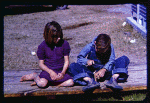
Boy Building a Model Airplane as Girl Watches, Robstown, Texas
Arthur Rothstein, photographer, January 1942.
FSA/OWI Color Photographs, 1938-1944 - Search on airplane in these collections to see images ranging from early planes to World War II aircraft: The latter collection also holds many wonderful views of Dayton taken during the years that the Wright brothers resided there.
- Learn more about one of Orville Wright's high school friends, the poet Paul Laurence Dunbar. Search the Today in History Archive on Dunbar.
- Read Americans' stories of flying by searching on airplane in the collection American Life Histories, 1936-1940. This search will retrieve the 1939 interview "An Air-Minded Family" in which Mrs. Edwards describes her family's obsession with planes sparked by her husband's passion for flying:
You know every man has a hobby, his was with airplanes when he closed his garage for the day instead of playing golf or working in the yard or garden he tinkered with his planes, my brothers just sat down. He begun building airplanes about two years before we married. He made a short flight in 1909.
"An Air-Minded Family," March 6, 1939.
American Life Histories, 1936-1940
Where History Meets Physical Science
On December 17, 1908, Willard Frank "Wild Bill" Libby was born on a farm in Grand Valley, Colorado. Libby won the 1960 Nobel Prize in Chemistry for his development of the technique known as radiocarbon dating.
Carbon dating is now a tool of many trades—archeology, geology, history, geophysics, and preservation among others. The technique uses an unstable isotope of carbon, carbon-14, to discern the age of physical phenomena as diverse as the end of the Ice Age, an old shoe, or funerary objects from a pharaoh's tomb.
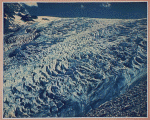
Illecillewaet Glacier from Crest, Selkirk Mountains, British Columbia
H. G. Peabody, photographer, circa 1902.
Touring Turn-of-the-Century America, 1880-1920
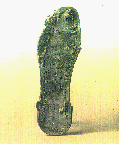
Sandal A, 1st century B.C.E.-1st century C.E.
Scrolls From the Dead Sea: The Ancient Library of Qumran and Modern Scholarship
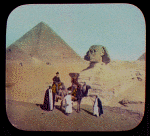
Pyramids and Sphinx, Jizah, Egypt
William Henry Jackson, photographer, December 1894.
Around the World in the 1890s, 1894-1896
As early as 1939 researchers discovered that neutron showers occur when cosmic rays hit atoms. They also learned that the neutrons were absorbed by nitrogen which then decayed into the unstable radioactive element carbon-14. Libby realized a series of additional facts:
- radioactive carbon-14 oxidized to carbon dioxide;
- plants absorbed carbon dioxide through photosynthesis;
- plants, directly or indirectly, were digested by all living organisms.
Therefore, he concluded, all living organisms, and all carbon containing products, were slightly radioactive.
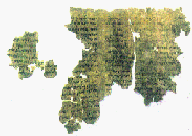
The Enoch Scroll
Parchment, Copied ca. 200-150 B.C.E.
Scrolls From the Dead Sea: The Ancient Library of Qumran and Modern Scholarship
Libby and others built increasingly sensitive Geiger counters to measure that radioactivity. The devices measured the half-life of radioactive carbon-14 in objects. Age was deduced based on the fact that about every 5,000 years carbon-14's radioactivity decays by one-half (over the next 5,000 by half again, and so on). Among the items Libby tested and dated were prehistoric sloth dung, charcoal from Stonehenge, and the parchment wrappings of the Dead Sea Scrolls.
Libby, who received a Ph.D. in chemistry from the University of California, Berkeley in 1933, joined the Manhattan Project after the U.S. entered World War II. After the war, he became a professor of chemistry at the University of Chicago where he did his work on radiocarbon dating. In 1954, Libby was appointed by President Dwight Eisenhower to the Atomic Energy Commission. He subsequently returned to academia at UCLA and passed away in 1980.

Berkeley Institute, Chemistry Lab, Brooklyn, New York
Gottscho-Schleisner, Inc., photographer, April 13, 1943.
Architecture and Interior Design for 20th Century America, 1935-1955
- Search across the American Memory pictorial collections using the terms chemisty or chemical for images such as manufacturing plants and laboratories, including the Chemical Laboratory at the House of David in Benton Harbor, Michigan.
- Digital images are being added monthly to Built in America: Historic Building and Engineering, 1933-Present which documents a wide range of building types and engineering technologies including, for example, Thomas Alva Edison's Chemistry Lab in West Orange, New Jersey. Search the collection on chemistry and chemical for more images.
- Visit the online exhibition Scrolls From the Dead Sea: The Ancient Library of Qumran and Modern Scholarship for a description of the scrolls and their historical context, including the Qumran community from whence they may have originated, and the story of their discovery 2,000 years later.
- Learn more about a wide variety of academic institutions in the United States. Search the Today in History Archive using the terms university and college.
